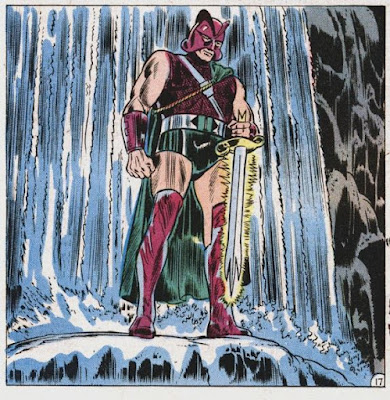cover art by Herb Trimpe
Hulk #205 (November 1976) returns to the saga of Jarella, the queen of a microscopic world who was enlarged along with the Hulk to become a part of our world. She can't go back, because someone stepped on the slide that contained Jarella's home world.
Jarella, though, is unconcerned with the genocide of her people, since she and Bruce Banner are in love. To be fair to her, it does turn out that Jarella's world wasn't actually destroyed, though it is in sad shape when Hulk pays them a return visit 40 issues later. Here's a Continuity Note from the Marvel Wiki about Hulk #247:
Oh, well. Comic Book Science is a complex thing, isn't it?
Anyway, Bruce and Jarella are out for a walk and a visit to an ice cream shop. But villainy is afoot. An unidentifed scientist, tired of being a nobody, has recovered an android called Crypto-Man. C-M once fought Thor but was defeated. The unnamed scientist has found and rebuilt him. Raving that he will no longer be a nobody, Nameless Guy sends C-M out to rob a bank.
Naturally, Bruce and Jarella are nearby. When C-M sees Jarella's green skin, Nameless Guy (observing the scene remotely) figures she might be connected with the Hulk and decides to have the android drain her of any power she might have.
The story is written by Len Wein and drawn by Sal Buscema and Joe Staton. They are a great team, as this moment in the story proves. The panels showing close-ups of Jarella as she becomes more fearful also show us Bruce's hands as he Hulks out, making Hulk's entrance into the story in the next panel very powerful.
The ensuing battle is pretty cool, with the two opponents slugging each other and Nameless Guy funneling more and more power into the android. But when falling debris threatens a child, the battle takes a turn. Jarella saves the kid, but is hit by the debris herself.
That gets Hulk angry. And, of course, if you are fighting the Hulk, you don't want to make him angry.
The android is destroyed. A power feedback kills Nameless Guy, with a bit of effective irony added when a narration panel tells us his body would be burned beyond recognition and forever unidentified when found. He wanted to be somebody, but he'll be nobody forever.
Jarella dies in Hulk's arms. Desperately, he takes her to Gamma Base, but she's beyond help.
The story ends with Hulk deciding to see his friend who can do magic to see if HE can help. We'll see how that works out when we look at the next issue in a few weeks.
It's a great story. Jarella's death carries an appropriate emotional impact and we can't help feeling compassion for the big green guy and can also understand his desperate refusal to accept her death.
Next week, we'll begin a look at a 2-part Superman story in which Clark Kent tries to figure out why his old home in Smallville is now haunted.

























































